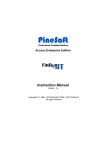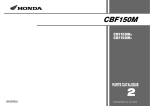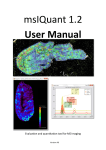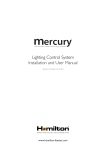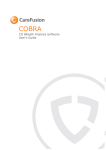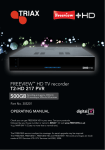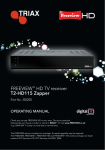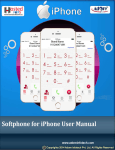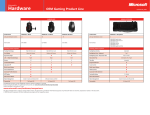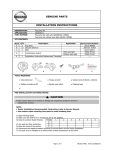Download BY HARRY SAAL The Society of PET Owners and Trainers
Transcript
BY HARRY SAAL The Society of PET Owners and Trainers Commodore's PET is a factory-assembled personal computer based on a 6502 microprocessor. The original PET\ model 2001-8, is a $795 system that includes a keyboard, cassette tape unit, built-in TV screen, some graphics, upper and lower case, extended 8K BASIC\ and 8K o f user memory. SPOT is devoted to the host o f applications-routine and wild-which PET users have found for their machines, as well as to the nitty-gritty o f repairs and modifications. In other words, almost anything relating to the PET is fit material for this column. Just send Harry your questions, ideas, and tapes c/o PCC. H ell give each o f them his careful atten tion. -L B The BASIC Programmer’s Toolkit adds powerful commands to the vocabulary of the PET: AUTO, DELETE, FIND, HELP, TRACE, STEP, OFF, RENUM BER, APPEND, DUMP, UNLIST. HEARD AROUND THE QUAYSIDE Commodore has gotten into substantial production of the new PET systems. Both 16- and 32K PETs are easily avail able. Disks and printers are harder to find, but it’s getting easier every day. I was pleasantly surprised to find that the User Manual has been updated for the new machines and included with them. Remember the traditional one-year delay in getting the manuals?! The Commodore Newsletter has been revamped, and Issue 3 is leagues ahead of the previous issues, though still far too heavy on “advertis ing” of Commodore products and too light on good technical info. The Commodore product line keeps changing, along with the prices. The 2001-32 computer now costs $1295, up from $1195. The 2040 dual-disk drive went up from $1095 to $1295, and the single-disk unit, the 2041, was withdrawn, as predicted by this column last issue. In its place, Commodore is offering a single-drive version of the 2040, called the 2040-A, for $895, which shares the sophistication of the dual-drive version. A much wiser plan! 54 RECREATIONAL COMPUTING The Toolkit is a collection of machine language firmware aids designed to enhance the development, debugging and polishing of BASIC programs for the PET. The Toolkit comes in the form of additional ROM storage, avoiding any need to load tapes or give up valuable RAM storage. For the 8K PET, the Tool kit is mounted on a special printed circuit board with edge connectors and attaches to the memory expansion port on the right-hand side of the PET. The 16- and 32K PET versions simply plug into a spare socket conveniently located inside the new PETs. Meanwhile, the low-cost 2021 electro sensitive printer has been withdrawn. The two versions of the matrix printer are ready, but the specs have changed. Both run at the same speed, and not bidirectionally, as previously stated. The 2022 differs in offering a tractor-type paper feed. Commodore promises to deliver new ROMs with the fixed BASIC for the 8K PETs sometime this summer, for about $50. Hurry up, CBM! Dealers are quoting good discounts on the 8K PET, making it an even better bargain than before. BASIC PROGRAMMER'S TOOLKIT I think this is one of the best products to come along in a while for the PET. Since I am one of the originators and developers of the BASIC Programmer’s Toolkit, I may be prejudiced, but let me describe it to you. Then make your own evaluation. When you type AUTO, for instance, the PET starts prompting you with line numbers, evenly spaced for you to enter lines. DELETE is like LIST in that it specifies a range of lines easily—except that it removes these lines from your pro gram in one quick step, instead of typing line number after line number laborious ly. FIND also resembles LIST, except it will list only selected lines which con tain some set of characters you specify. Thus with one command you can find all references to the variable “W9”, for example. HELP is a command useful in debugging programs. Whenever you get an error message from BASIC, type HELP, and the system will automatically list the line that BASIC quit on and highlight (in reverse video) the erroneous portion. You can also TRACE a program or single STEP it. After you type one of these commands, the Toolkit displays the last six line numbers executed by your pro gram in a reverse video window in the upper right-hand comer of the screen, scrolling them up as you proceed in your program. STEP is like TRACE except that only one statement is execu- ted until you press the SHIFT key to cause it to advance to the next. OFF removes you from TRACE or STEP mode. RENUMBER will do just that—assign new line numbers to all your statements, starting with any value, using even in crements you specify and adjusting all references in the process. Done entire ly in machine language, it handles line numbers which grow or shrink and is great when you’re trying to add more lines to an existing program. APPEND resembles LOAD and has the same basic syntax; however, it does not erase the current program. Rather, it adds the proggram found on tape immediately after the last statement currently in memory, thus enabling you to keep a library of subroutines on tape, incorporating them as required. The tapes are standard pro grams saved using the PET’s SAVE command, rather than some exotic ASCII tapes required by other published methods. DUMP displays the names and values of variables in an executing BASIC pro gram. It’s useful for understanding how someone else’s program works or deter mining what caused a particular problem without having to scan every statement of text. Finally, UNLIST is used to make a version of a program that will not LIST on the screen—a handy thing to have in situations where the answers to test questions, secret words, etc. are buried in DATA statements, thus giving away answers to someone who can read BASIC. The resulting program can be saved on tape as usual, and run on any standard PET, even without the Toolkit installed. I’m pretty proud of the BASIC Program mer’s Toolkit. Check with your local dealer to see if he or she has it in stock yet, or order directly from the Palo Alto IC’s (a subsidiary of Nestar Systems, Inc.), 810 Garland Drive, Palo Alto, CA 94303. The cost is $75 for the 8K version and only $50 for the 16- or 32K version, including documentation. Be sure to include 6lA% sales tax in California and $2.50 for shipping and handling. REVIEW: CURSOR MAGAZINE Cursor Magazine, published by Ron Jeffries, P.O. Box 550, Goleta, CA 93017, produces a fine set of PET pro grams every month. Spot offers a regular review of this cassette “magazine.” The March 1979 issue is good, although not one of the “stellar” issues. The Cover leads off with a neat graphics demo, showing a pattern which weaves over and under as it builds on the screen. The next program is Reversi, a computerized ver sion of the popular Othello game. The instructions are well presented, but similar versions of this intriguing game are around already. Dbook, a datebook program, is very useful. It lets you keep lists of things to do or people to call, in an organized fashion. This program alone pays for the March issue. Space is just one more version of the shoot-em-down game where you have to line up a target in your sights and firethough, in the Cursor tradition, it is better than others around. Maze is the program of the month for killing time; it is fun and uses superb graphics in a game where you have to search your way through an invisible maze (drawn on the screen as you explore it), looking for hidden treasure. This program is a good example of using the PET graphics and keyboard in a game situation. Add is quite a practical educational program for reviewing addition skills. It prompts the student systematically, from right to left, for column sums, carries, etc., leading you by the hand (keyboard?) to correct solutions at various levels. This is much better than anything like it I’ve seen. Finally, X is a “shell” program, used by Cursor to systematize its instruction presenta tion, input routines, etc. Anyone submit ting a program is requested to use X as the standard model. SOME COMMON BASIC PROGRAMS Another bargain! The very popular book from Osborne and Associates, Some Common BASIC Programs, has been put on tape. All 76 programs for $10 . . . already converted to run on the PET. The book itself is available for $8.50. Contact your local dealer, or Osborne and Associates, 630 Bancroft Way, Berkeley, CA 94710. CALL FOR TAPES! As mentioned before, this column will not review programs without having seen them run. So if you have something worthwhile, either for free or sale, don’t send a printed new product an nouncement. That won’t get in SPOT... Send cassettes. □ JUL-AUG 1979 55 Reviews TRS-80 TRON (a series) This review covers issues #10 and #11 of CLOAD, the RENUM program avail able from Radio Shack, and a publication called TRS-80 Computing. CLOAD is a magnetic tape magazine published monthly on cassette. The price is $36 annually, or you can pur chase a single copy for $3.50 (add sales tax in California). The address is: CLOAD, P.O. Box 1267 Goleta, CA 93017 CLOAD #10 has six programs listed on the tape: CLOAD cover, States Quiz, Reaction Test, Sketch, 4 Color, and Juke Box. A different format has been used for the cover program this issue. Inside a frame, the words “HUNGRY BUG” are printed and a bug (spot) bounces around until all the words are eaten. There are two great programs that fall into the CAI (Computer Assisted Instruc tion) category, the States Quiz and 4 Color. The States Quiz, which can be used in the classroom, outlines the 48 contiguous states; Alaska and Hawaii also randomly appear. You can select how you wish to be tested—state, capital, postal abbreviation, or any combina tion of the three. You can select either a random or alphabetical presentation of the test. A spot appears on the screen and flashes in the location of a state. 4 Color checks out your analytical prowess. A large square map with random subdivisions is printed on your screen. You are given four colors, and you must fill in the map without the same color touching at the sides or corners. There are three levels of difficulty and, as far as I can determine, only one minor glitch. If you use the color blue in the two lower righthand blocks, the program accepts the error. This doesn’t occur in any other section. 56 RECREATIONAL COMPUTING Sketch is similar to the Sketch-o-Graph toys you find in department stores. It allows you to sketch a line the length of your monitor screen with one command. This program is excellent for youngsters. of special cards is used showing circles, stars, plus signs, boxes, and waves. If you are interested in ESP and determin ing your PSI powers, this is the program for you. Reaction Test flashes a counter on the screen using random locations and times. When you see the counter, you hit the space bar. It could be a wonderful party gimmick to test out the reflexes of onetoo-many-for-the-road guests. RENUM is a program distributed by all Radio Shack Stores. It costs $9.95 and consists of four cassettes. It is basically the same as ones sold by other software houses, but a better buy. It is machine language and can be used with any TRS80 Level II unit and with TRSDOS systems. You can load it before or after a Level II program is in your machine. It is an excellent method for expanding or compressing line numbers, “cleaning up” a program by converting to uniform line number increments, or adapting existing subroutine line numbers to suit the particular routine you plan to type in. The accompanying instructions are com prehensive and easy to read. This is an excellent program to have in your tape library. Wrapping up this issue is Juke Box. By placing an AM radio near your keyboard, you have a choice of six tunes. Don’t expect it to sound like your stereo, but it does show that computers can soothe the savage beast. CLOAD #11 has only four programs. They are: a cover of random rectangular designs; Speedway, in which you race a spot (car) around a track; Nym, where the player to take the last stone wins; and the main program, an ESP test. Speedway can be easily defeated by running the spot (car) past the starting point two times. Nym is the same as the prolifera tion of NIM games seen in many com puter publications. The ESP program tests for precognition, clairvoyance, tele pathy, retrogression, and telekenesis. This is not a game but is patterned on the tests given at Duke University. A deck TRS-80 Computing: This excellent publi cation is issued by the Computer Infor mation Exchange, Inc., P.O. Box 158,San Luis Rey, CA 92068. It costs $1.50 an issue, or $15 for 12 issues. It is loaded with features pertaining to Level I and II BASIC, DOS, Disk BASIC; as well as hardware modifications; and common TRS-80 problems and their solutions. You’ll also find such hints as how to modify your system for lowercase or how to run a cassette independently of the CPU while listening to programs being loaded or saved. Your $15 is for 12 issues—not one year—and herein lies the major problem with TRS-80 Com puting. Since August 1978, only three issues have been published. All are great, with much information not found else where. If you don’t mind being patient for your next issue, this is a top-rated publication. Reviewed by Joseph F. Fouke El Granada, California



